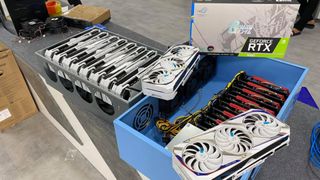Will Nvidia need to protect the RTX 40 series GPUs from cryptomining madness?
The future of PC gaming is turbulent and unpredictable

The last few weeks have provided some well-deserved respite for PC gamers and computer builders, after what has been a fairly horrendous two years since the launch of the Nvidia Ampere and AMD RDNA2 graphics architecture.
Where we once faced global shortages and skyrocketing prices thanks to a dastardly mix of different issues, it's now fairly easy to walk into a brick and mortar store to buy a reasonably priced graphics card, or add one to your online basket without having to worry that it'll have sold out by the time you've finished going through the transaction process.
This is a relief for many, and yet I still feel on edge. The multitude of problems that caused the original situation hasn't entirely been resolved, which means we could slip right back into depressing familiarity when Nvidia and AMD launch their next generation of desktop graphics cards towards the end of this year.
One of the most recognizable blights was that of cryptomining, and the surge in demand for GPUs to be used in mining rigs, both in small-scale operations, right up to warehouses housing industrial mining farms. Bots were used by miners to buy up the available stock of desirable GPUs such as the GeForce RTX 3060 and the Radeon RX 6700 XT before traditional consumers could complete their purchases.
Opportunists saw this sudden rise in demand and also got involved, which only made matters worse. By also buying up stock, they could then re-list cards on sites such as eBay or Facebook Marketplace for a profit, which inflated the original retail price by a mind-boggling sum. At the height of it, RTX 3080s were often listed at over three times their actual price.
How did the crypto craze cause gamers suffering?

Interestingly, cryptomining itself likely played a smaller part in the overall GPU shortage than you might assume, given the global chip shortage was also causing manufacturing delays. However, that didn't stop miners from being seen as public enemy number one to desperate consumers looking to buy a reasonably priced card.
Nvidia did eventually try and reclaim some of its lost public appeal by re-releasing almost the entire RTX 30 series as LHR or 'low hashrate' versions of the originals, which limited their ability to mine cryptocurrency without impacting in-game performance. Almost the entire RTX 3000-series of cards have contained hashrate limiters since (not including the GeForce RTX 3090 as it was deemed too expensive to attract the mining market) which limited their ability to mine currencies like ETH, but several of these were quickly defeated. Some software was able to unlock cards to 70-80% efficiency in a matter of mere weeks.
Get daily insight, inspiration and deals in your inbox
Get the hottest deals available in your inbox plus news, reviews, opinion, analysis and more from the TechRadar team.
It's genuinely hard to say if this had any real impact, though some credibility was lost over its security when Nvidia accidentally broke its own LHR software with a botched driver update.
In the end, it's taken almost a full year for the LHR software to be completely unlocked thanks to a company called NiceHash, but even this only works on older versions of the LHR algorithm, and doesn't include systems running on Linux. Nvidia has been diligent to keep updating its LHR software, but we don't know if this will carry over to its next generation of GPUs. We've emailed Nvidia for some clarification, but it's worth remembering that we could see a very similar situation unfold later this year, even if cryptomining continues to fall in popularity.
You might think of Bitcoin at the mention of cryptomining, but it was actually Ethereum, the world's second most popular currency, that was causing issues for gamers back in 2020. Luckily, Ethereum started to move to proof-of-stake at the end of 2021, using validators to find a block based on the number of tokens they hold. The current proof-of-work system has computers competing against each other to be the first to solve complex puzzles, which allows miners to use warehouses full of consumer graphics cards to solve those puzzles, mining ETH more intensively in the process.
As ETH moves over to proof-of-stake, the need for those 'puzzles' to be solved disappears, and the viability to mine using traditional methods vanishes with it. That said, there's nothing to stop Ethereum's success from being replicated by another currency that still uses the proof-of-work validation method, especially with the ongoing threat of a financial crisis looming across the western world.
It's only natural that desperate people will try and make some cash in a decentralized market, especially after seeing the success of people who invested in Bitcoin back in 2009.
This is especially prevalent with Elon Musk buying Twitter, a man known for holding massive influence over the wider crypto market and who may soon be able to model Twitter into a platform that's better optimized to deal with the ever-changing world of digital investment portfolios. All it takes is for a low-value currency that's viable for mining with consumer GPUs and it could rapidly feel like we're back in the same inescapable hardware shortage once again.
Remain alert and learn from recent history

I don't mean for any of this to come across as fear-mongering. I was actually relieved to be able to report on falling GPU prices and improved availability after spending the better part of the last two years writing about how depressing the market was for both new and established PC gamers at the time who just wanted to buy a new graphics card, but I don't want to fall into a false sense of security because of this current respite.
To escape the same situation unfolding, we need a perfect storm that works in our favor. We need for supplies of the next generation of GPUs to be plentiful (which could be impacted by the recent Covid-19 lockdowns across East Asia where most of the hardware is manufactured), we need the Crypto market to either remain stable or spiral downward to deter potential investors, and we need these new graphics cards to be reasonably priced at launch and then - somehow - remain that way in spite of high demand.
AMD has made it clear that consumers can use its cards for anything they want as they have purchased them outright, so it's unlikely that Team Red will be implementing a similar deterrent as the Nvidia LHR algorithm, and Intel appears to share this sentiment after announcing that the ARC Alchemist desktop graphics cards will launch without any cryptocurrency mining handicaps.
If Nvidia does decide to carry LHR tech over to the Lovelace generation of cards then it will be alone, but that isn't necessarily bad news. If the preventative measures work then nobody loses as miners will be driven towards Intel and AMDs offerings to supply their farming rigs, while gamers, developers, and desktop PC builders can source their hardware from Team Green, which might place it in better public standing than its rivals.
While this is all speculative, it's important to remain vigilant in the coming months as interest for the next generation of graphics cards grows, so that you're in the best possible to buy one at launch.
If we can take anything useful away from the last two years, it's that nabbing a founders edition GPU directly from the manufacturer was one of the only ways to get a card at MSRP, which might be your best option to avoid months of misery when trying to upgrade your current system. Best start warming up your fingers now for some fast basket-adding... just in case.
Jess is a former TechRadar Computing writer, where she covered all aspects of Mac and PC hardware, including PC gaming and peripherals. She has been interviewed as an industry expert for the BBC, and while her educational background was in prosthetics and model-making, her true love is in tech and she has built numerous desktop computers over the last 10 years for gaming and content creation. Jess is now a journalist at The Verge.
Most Popular




